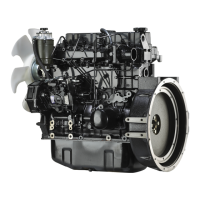40 / 46
Operation Manual Mitsubishi SS-Series diesel engines
Version 08/2004
ENGLISH
COOLANT AND ANTIFREEZE SPECIFICATIONS
they are meant to protect, they are used up due to
aging and this allows some metals to precipitate
into the coolant or to form new compounds which
can result in rusty surface deposits. Some
chemicals, calculated to inhibit this ionic reaction,
might accelerate the reaction of those metals that
have already begun to react.
The worse case scenario is that the process of the
ionic reaction or corrosion will go on faster than
when the coolant is straight water without
additives, if there is not a good match between the
chemical proportions and the circuit metals.
9.6 Practical reported cases of
circuit trouble for which
additive is blamed
Case 1:
Amines are generally effective in suppressing the
rusting of ferrous metals but are said to be
problematic for copper and cupric metals because
of copper involvement in pittings reported on Fe
metals. The mechanism of Fe-surface pitting may
be explained as that of galvanic or local-cell
action. Suppose a cluster of copper molecules
precipitates and deposits itself on a surface of Fe,
a base metal relative to copper. The copper
deposit introduces a localized galvanic cell which,
by its ionic action, rapidly eats into the Fe surface
to result in a pit.
Case 2:
A silicate (there are several types of silicate) is
highly effective in protecting aluminium against
rusting. This compound of silicon is unstable in a
solution whose pH is 9 or less: it is prone to turn to
gel and settle down in the solution. For this
reason, the pH is usually specified to be 10 or so.
This means that the silicate has to be used in a
high-alkalinity coolant. When the silicate is used
up, the high alkalinity starts chemically attacking
the aluminium.
Example
The mechanical seal of the water pump may
rapidly wear down as the secondary effect of
silicate gel in the above context.
Case 3:
As the additive as a whole deteriorates or when its
concentration in the coolant is too low, its anti-
corrosion performance falls and consequently the
circuit metals begin to corrode. Of those metals
badly affected in such a condition, brass and
solder — the materials used in the cores of the
radiator — become particularly victimized. The
cause of coolant leakage from and clogging of the
coolant circuit in the radiator is usually traceable to
such a malcondition of the coolant.

